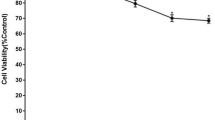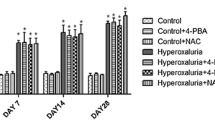Abstract
Renal cellular exposure to oxalate (Ox) and/or CaOx crystals leads to the production of reactive oxygen species (ROS), development of oxidative stress followed by injury and inflammation. Renal injury and inflammation appear to play a significant role in stone formation. ROS are produced from many sources and involve a variety of signaling pathways. Tissue culture and animal model studies show that treatments with anti-oxidants and free radical scavengers reduce Ox/CaOx crystal induced injuries. In addition, CaOx crystal deposition in kidneys is significantly reduced by treatments with antioxidants and free radical scavengers, indicating their efficacy. These results point towards a great potential for the therapeutic application of antioxidants and free radical scavengers to reduce stone recurrence particularly after shock wave lithotripsy, which is itself known to generate ROS and cause renal damage.





Similar content being viewed by others
References
Danpure CJ, Purdue PE (1995) Primary hyperoxaluria. In: Scriver CR, Beaudet AL, Sly WS, Valle D (eds) The metabolic and molecular bases of inherited disease, 7th edn. McGraw-Hill, New York, p 2385
Hatch M, Freel RW, Vaziri ND (1999) Regulatory aspects of oxalate excretion in enteric oxalate elimination. J Am Soc Nephrol 10: S324
Hackett RL, Shevock PN, Khan SR (1994) Madin-Darby canine kidney cells are injured by exposure to oxalate and to calcium oxalate crystals. Urol Res 22: 197
Koul H, Kenington L, Nair G, Honeyman T, Menon M, Scheid CR (1994) Ox-induced initiation of DNA synthesis in LLC-PK1 cells, a line of renal epithelial cells. Biochem Biophys Res Commun 205: 1632
Koul H, Kenington L, Honeyman T, Jonassen J, Menon M, Scheid CR (1996) Activation of the c-myc gene mediates the mitogenic effects of Ox in LLC-PK1 cells, a line of renal epithelial cells. Kidney Int 50: 1525
Khan SR (1995) Calcium oxalate crystal interaction with renal tubular epithelium, mechanism of crystal adhesion and its impact on stone development. Urol Res 23: 71
Khan SR (2004) Crystal-induced inflammation of the kidneys: results from human studies, animal models, and tissue culture studies. Clin Exp Nephrol 8: 75
Khan SR (2004) Role of renal epithelial cells in the initiation of calcium oxalate stones. Nephron Exp Nephrol 98: 55
Scheid CR, Koul H, Hill WA, Luber-Narod J, Kennington L, Honeyman T, Jonassen J, Menon M (1996) Ox toxicity in LLC-PK1 cells: role of free radicals. Kidney Int 49: 413
Thamilselvan S, Hackett RL, Khan SR (1997) Lipid peroxidation in ethylene glycol induced hyperoxaluria and CaOx nephrolithiasis. J Urol 157: 1059
Thamilselvan S, Hackett RL, Khan SR (2000) Free radical scavengers catalase and superoxide dismutase provide protection from oxalate associated injury to LLC-PK1 and MDCK cells. J Urol 164: 224
Thamilselvan S, Khan SR, Menon M (2003) Oxalate and calcium oxalate mediated free radical toxicity in renal epithelial cells: effect of antioxidants. Urol Res 31: 3
Drodge W (2001) Free radicals in the physiological control of cell function. Physiol Rev 82: 47
Kamata H, Hirata H (1999) Redox regulation of cellular signalling. Cell Signal 11: 1
Huang H-S, Ma M-C, Chen C-F, Chen J (2003) Lipid peroxidation and its correlations with urinary levels of oxalate, citric acid, and osteopontin in patients with renal calcium oxalate stones. Urology 61: 1123
Tungsanga K,Sriboonlue P, Futrakul P, Yachantha C, Tosukhowong P (2005) Renal tubular cell damage and oxidative stress in renal stone patients and the effect of potassium citrate treatment. Urol Res (in press)
Khand FD, Gordge MP, Robertson WG, Noronha-Dutra AA, Hothersall JS (2002) Mitochondrial superoxide production during oxalate mediated oxidative stress in renal epithelial cells. Free Radic Biol Med 32: 1339
Cao L-C, Honeyman T, Jonassen J, Scheid C (2000) Oxalate-induced ceramide accumulation in Madin-Darby canine kidney and LLC-PK1 cells. Kidney Int 57: 2403
Byer K, Khan SR (2005) Citrate provides protection against oxalate and calcium oxalate crystal induced oxidative damage to renal epithelium. J Urol 173: 640
Toblli JE, Ferder L, Stella I, De Cavanagh MVE, Angerosa M, Inserra F (2002) Effects of angiotensin II subtype 1 receptor blockade by losartan on tubulointerstitial lesions caused by hyperoxaluria. J Urol 168: 1550
Huang H-S, Ma M-C, Chen J, Chen C-F (2002) Changes in the oxidant-antioxidant balance in the kidneys of rats with nephrolithiasis induced by ethylene glycol. J Urol 167: 2584
Chen D H-C, Kaung H-LC, Miller CM, Resnick MI, Marengo SR (2004) Microarray analysis of changes in renal phenotype in the ethylene glycol rat model of urolithiasis: potential and pitfalls. BJU Int 94: 637
Cao L-C, Honeyman T, Cooney R, Kennington L, Scheid C R, Jonassen J A, (2004) Mitochondrial dysfunction is a primary event in renal cell oxalate toxicity. Kidney Int 66: 1890
Li N, Yi FX, Spurrier JL, Bobrowitz CA, Zou AP (2002) Production of superoxide through NADH oxidase in thick ascending limb of the loop in rat kidney, Am J Physiol 282: F1111
Geiszt M, Kopp JB, Varnai P, Leto TL (2000) Identification of renox, an NAD(P)H oxidase in kidney. Proc Natl Acad Sci U S A 97: 8010
Hanna IR, Taniyama Y, Szocs K, Rocic P, Griendling KK (2002) NAD(P)H oxidase-derived reactive oxygen species as mediators of angiotensin II signaling. Antioxid Redox Signal 4: 899
Griendling KK, Minieri CA, Ollenrenshaw JD, Alexander RW (1994) Angiotensin II stimulates NADH and NADPH oxidase activity in cultured vascular smooth muscle cells. Circ Res 74: 1141
James EA, Galceran JM, Raij L (1998) Angiotensin II induces superoxide anion production by mesangial cells. Kidney Int 54: 775
Umekawa T, Hatanaka Y, Kurita T, Khan SR (2004) Effect of angiotensin II receptor blockage on osteopontin expression and calcium oxalate crystal deposition in the rat kidneys. J Am Soc Nephrol 15: 635
Toblli JE, Ferder L, Stella I, Angerosa M, Inserra F (2001) Protective role of enalapril for chronic tubulointerstitial lesions of hyperoxaluria. J Urol 166: 275
Umekawa T, Byer KJ, Khan SR (2004) NADPH oxidase as a source of reactive oxygen species in oxalate and calcium oxalate crystal induced injury of renal epithelial cells. In: Kidney stones: inside and out, Proceedings of the 10th International Symposium on Urolithiasis, Hong Kong, 2004, The reprographic unit, Hong Kong Polytechnic University, Hong Kong, p 118
Umekawa T, Byer K, Uemura H, Khan SR (2005) Diphenyleneiodium (DPI) reduces oxalate ions and calcium oxalate monohydrate and brushite crystal-induced up-regulation of MCP-1 in nrk 52e cells. Nephrol Dial Transplant (in press)
Rashid T, Menon M, Thamilselvan S (2004) Molecular mechanism of oxalate-induced free radical production and glutathione redox imbalance in renal epithelial cells: effect of antioxidants. Am J Nephrol 24: 557
Chaturvedi LS, Koul S, Sekhon A, Bhandari A, Menon M, Koul HK (2002) Oxalate selectively activates the p38 mitoge-activated protein kinase and c-Jun N-terminal kinase signal transduction pathway in renal epithelial cells. J Biol Chem 277: 13321
Koul HK, Menon M, Chaturvedi LS, Koul S, Sekhon A, Bhandari A, Huang M (2002) COM crystals activate the p38 mitoge-activated protein kinase (MAPK) signal transduction pathway in renal epithelial cells. J Biol Chem 277: 36845
Han HJ, Lim MJ, Lee YJ (2004) Oxalate inhibits renal proximal tubule cell proliferation via oxidative stress, p38 MAPK/JNK, and cPLA2 signaling pathways. Am J Physiol Cell Physiol 287: C1058
Jonassen JA, Cao LC, Honeyman T, Scheid CR(2003) Mechanisms mediating oxalate-induced alterations in renal cell functions. Crit Rev Eukaryot Gene Expr 13: 55
Antus B, Exton MS, Rosivall L (2001) Angiotensin II: a regulator of inflammation during renal disease? Int J Immunopathol Pharmacol 14: 25
Toblli JE, Ferder L, Angerosa M, Inserra F (1999) Effects of amlodipine on tubulointerstitial lesions in normotensive hyperoxaluric rats. Hypertension 34: 854
Khan SR, Kok DJ (2004) Modulators of urinary stone formation. Front Biosci 9: 1450
Khan SR, Byer KJ, Thamilselvan S, Hackett RL, McCormack WT, Benson NA, Vaughn KL, Erdos GW (1999) Crystal-cell interaction and apoptosis in oxalate-associated injury of renal epithelial cells. J Am Soc Nephrol 10: S457
Miller C, Kennington L, Cooney R, Kohjimoto Y, Cao LC, Honeyman T, Pullman J, Jonassen J, Scheid C (2000) Oxalate toxicity in renal epithelial cells: characteristics of apoptosis and necrosis. Toxicol Pharmacol 162: 132
Khan SR, Finlayson B, Hackett RL (1982) Experimental calcium oxalate nephrolithiasis in the rat, role of renal papilla. Am J Pathol 107: 59
Khan SR (1995) Experimental CaOx nephrolithiasis and the formation of human urinary stones. Scanning Microsc 9: 89
Fasano JM, Khan SR (2001) Intratubular crystallization of calcium oxalate in the presence of membrane vesicles: an in vitro study. Kidney Int 59: 169
Riese RJ, Mandel NS, Wiessner JH, Mandel GS, Becker CJ, Kleinman JC (1992) Cell polarity and CaOx crystal adherence to cultured collecting duct cells. Am J Physiol 262: F177
Verkoelen CF, Van der Broom BG, Houtsmuller AB, Schroeder FH, Romijn JC (1998) Increased CaOx monohydrate crystal binding to injured renal epithelial cells in culture. Am J Physiol 274: F958
Bigelow MW, Wienner JH, Kleinman JC, Mandel NS (1999) Surface exposure of PS increases CaOx crystal attachment to IMCD cells. Am J Physiol 272: F55
Wiessner JH, Hasegawa AT, Hung LY, Mandel NS (1999) Oxalate-induced exposure of PS on surface of renal epithelial cells in culture. J Am Soc Nephrol 10: S441
Thamilselvan S, Selvam R (1997) Effect of vitamin E and mannitol on renal calcium oxalate retention in experimental nephrolithiasis. Indian J Biochem Biophys 34: 319
Kumar S, Selvam R (2003) Supplementation of vitamin E and selenium prevents hyperoxaluria in experimental urolithic rats. J Nutr Biochem 14: 306
Selvam R, Ravichandran V (1993) Restoration of tissue antioxidants and prevention of renal stone deposition in vitamin B6 deficient rats fed with vitamin E or methionine. Indian J Exp Biol 31: 882
Muthukumar A, Selvam R (1998) Role of glutathione on renal mitochondrial status in hyperoxaluria. Mol Cell Biochem 185: 77
Ito Y, Yasui T, Okada A, Tozawa K, Hayashi Y, Kohri K (2005) Preventive effects of green tea on renal stone formation and the role of oxidative stress in nephrolithiasis. J Urol 173: 271
Umekawa T, Chegini N, Khan SR (2002) Oxalate ions and calcium oxalate crystals stimulate MCP-1 expression by rnal epithelial cells. Kidney Int 61: 105
Pearle MS (2001) Prevention of nephrolithiasis. Curr Opin Nephrol Hypertens 10: 203
Vaziri ND (2004) Roles of oxidative stress and antioxidant therapy in chronic kidney disease and hypertension. Curr Opin Nephrol Hypertens 13: 93
Griendling KK, Fitzgerald GA (2004) Oxidative stress and cardiovascular injury. Part II: animal and human studies. Circulation 108: 2034
Meagher EA (2003) Treatment of atherosclerosis in the new millennium: is there a role for vitamin E? Prev Cardiol Spring 6(2): 85
Hasnain BI, Mooradian AD (2004) Recent trials of antioxidant therapy: what should we be telling our patients? Cleve Clin J Med 71: 327
Baxmann AC, Mendonca COG, Heilberg IP (2003) Effect of vitamin C supplements on urinary oxalate and pH in calcium oxalate stone forming patients. Kidney Int 63: 1066
Author information
Authors and Affiliations
Corresponding author
Rights and permissions
About this article
Cite this article
Khan, S.R. Hyperoxaluria-induced oxidative stress and antioxidants for renal protection. Urol Res 33, 349–357 (2005). https://doi.org/10.1007/s00240-005-0492-4
Received:
Accepted:
Published:
Issue Date:
DOI: https://doi.org/10.1007/s00240-005-0492-4




